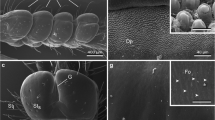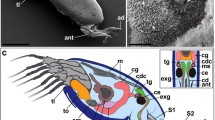Abstract
Barnacles are sessile marine crustaceans that produce a proteinaceous cement to attach themselves to the underwater surfaces of natural or man-made structures. This work was carried out to characterize the cement apparatus and localize this structure in the peduncle of the stalked barnacle Pollicipes pollicipes. Light and transmission electron microscopy techniques were used for these purposes. Sections of the peduncle revealed a central core encircled by a thick layer of muscular tissue. The cement apparatus, formed by clusters of adhesive-secreting cells and ducts, was located in the central core embedded in an apical layer of connective tissue with a thickness of a few mm, just beneath the capitulum. The ovary was also found in the peduncular core, but most of it was located below the region containing the cement apparatus. The cytoplasm of adhesive-secreting cells was very rich in rough endoplasmic reticulum and also contained small electron-dense secretory vesicles. Histochemical methods applied to semithin sections showed that these vesicles were filled with proteins, being also PAS positive. The voluminous nuclei of these cells presented diverse and irregular shapes, typically with very thin and long extensions, containing large nucleoli and a great amount of heterochromatin. Electron-dense inclusions with a concentric lamellar structure were also seen in these nuclei, resembling nuclear inclusions reported in fish oocytes. These cells presented the features of very active protein-secreting cells, being similar to the adhesive-secreting cells of other species of stalked barnacles.


Similar content being viewed by others
References
Aldred N, Høeg JT, Maruzzo D, Clare AS (2013) Analysis of the behaviours mediating barnacle cyprid reversible adhesion. Plos ONE 8(7):e68085
Azevedo C (1976) Intranuclear membranous inclusions in oocytes of a viviparous teleost (Xiphophorus helleri). J Cell Sci 22:325–334
Buckeridge JS, Newman WA (2006) A revision of the Iblidae and the stalked barnacles (crustacea: cirripedia: thoracica), including new ordinal, familial and generic taxa, and two new species from New Zealand and Tasmanian waters. Zootaxa 1136:1–38
Cruz T, Jacinto D, Sousa A, Penteado N, Pereira D, Fernandes JN, Silva T, Castro JJ (2015) The state of the fishery, conservation and management of the stalked barnacle Pollicipes pollicipes in Portugal. Mar Environ Res 112:73–80
Foster BA (1987) Barnacle ecology and adaptation. In: Southward AJ (ed) Crustacean Issues 5, barnacle biology. AA Balkema, Rotterdam, pp 113–133
Gale AS (2015) Origin and phylogeny of the verrucomorph barnacles (crustacea, cirripedia, thoracica). J Syst Palaeontol 13:753–789
Ganter P, Jollès G (1970) Histochimie normal et pathologique. Gauthier-Villars, Paris
Gohad NV, Aldred N, Hartshorn CM, Lee YJ, Cicerone MT, Orihuela B, Clare AS, Rittschof D, Mount AS (2014) Synergistic roles for lipids and proteins in the permanent adhesive of barnacle larvae. Nat Commun 5:4414
He L-S, Zhang G, Qian P-Y (2013) Characterization of two 20 kDa-cement protein (cp20 k) homologues in Amphibalanus amphitrite. Plos ONE 8(5):e64130
Høeg JT, Maruzzo D, Okano K, Glenner H, Chan BKK (2012) Metamorphosis in balanomorphan, pedunculated, and parasitic barnacles: a video-based analysis. Integr Comp Biol 52:337–347
Jonker J-L, von Byern J, Flammang P, Klepal W, Power AM (2012) Unusual adhesive production system in the barnacle Lepas anatifera: an ultrastructural and histochemical investigation. J Morphol 273:1377–1391
Jonker J-L, Abram F, Pires E, Coelho AV, Grunwald I, Power AM (2014) Adhesive proteins of stalked and acorn barnacles display homology with low sequence similarities. Plos ONE 9(10):e108902
Jonker J-L, Morrison L, Lynch EP, Grunwald I, von Byern J, Power AM (2015) The chemistry of stalked barnacle adhesive (Lepas anatifera). Interface Focus 5:20140062
Kamino K (2008) Underwater adhesive of marine organisms as the vital link between biological science and material science. Mar Biotechnol 10:111–121
Kamino K (2013) Mini-review: barnacle adhesives and adhesion. Biofouling 29:735–749
Kamino K, Nakano M, Kanai S (2012) Significance of the conformation of building blocks in curing of barnacle underwater adhesive. FEBS J 279:1750–1760
Lacombe D, Liguori VR (1969) Comparative histological studies of the cement apparatus of Lepas anatifera and Balanus tintinnabulum. Biol Bull 137:170–180
Linse K, Jackson JA, Fitzcharles E, Sands CJ, Buckeridge JS (2013) phylogenetic position of Antarctic scalpelliformes (crustacea: cirripedia: thoracica). Deep Sea Res I 73:99–116
Lobo-da-Cunha A, Oliveira E, Ferreira I, Coelho R, Calado G (2010) Histochemical and ultrastructural characterization of the posterior esophagus of Bulla striata (mollusca, opisthobranchia). Microsc Microanal 16:688–698
Ödling K, Albertsson C, Russell JT, Mårtensson LGE (2006) An in vivo study of exocytosis of cement proteins from barnacle Balanus improvisus (D.) cyprid larva. J Exp Biol 209:956–964
Pérez-Losada M, Harp M, Høeg JT, Achituv Y, Jones D, Watanabe H, Crandall KA (2008) The tempo and mode of barnacle evolution. Mol Phylogenet Evol 46:328–346
Power AM, Klepal W, Zheden V, Jonker J, McEvilly P, von Byern J (2010) Mechanisms of adhesion in adult barnacles. In: von Byern J, Grunwald I (eds) Adhesion phenomena in nature. Springer, New York, pp 153–167
Stewart RJ (2011) Protein-based underwater adhesives and the prospects for their biotechnological production. Appl Microbiol Biotechnol 89:27–33
Van Syoc RJ, Fernandes JN, Carrison DA, Grosberg RK (2010) Molecular phylogenetics and biogeography of Pollicipes (crustacea: cirripedia), a tethyan relict. J Exp Mar Biol Ecol 392:193–199
Walker G (1970) The histology, histochemistry and ultrastructure of the cement apparatus of three adult sessile barnacles, Elminius modestus, Balanus balanoides and Balanus hameri. Mar Biol 7:239–248
Walker G (1971) A study of the cement apparatus of the cypris larva of the barnacle Balanus balanoides. Mar Biol 9:205–212
Walker G (1974) The occurrence, distribution and attachment of the pedunculate barnacle Octolasmis mülleri (Coker) on the gills of crabs, particularly the blue crab, Callinectes sapidus rathbun. Biol Bull 147:678–689
Walker G (1978) A cytological study of the cement apparatus of the barnacle, Chelonibia testudinaria linnaeus, an epizoite on turtles. Bull Mar Sci 28:205–209
Walker G (1992) Cirripedia. In: Harrison FW, Humes AG (eds) Microscopic anatomy of invertebrates 9, crustacea. Wiley-Liss, NewYork, pp 249–311
Walker G, Yule AB (1984) Temporary adhesion of the barnacle cyprid: the existence of an antennular adhesive secretion. J Mar Biol Assoc UK 64:679–686
Zheden V, von Byern J, Kerbl A, Leisch N, Staedler Y, Grunwald I, Power AM, Klepal W (2012) Morphology of the cement apparatus and the cement of the buoy barnacle Dosima fascicularis (crustacea, cirripedia, thoracica, lepadidae). Biol Bull 223:192–204
Acknowledgements
This work was supported by funds provided by the Abel Salazar Institute of Biomedical Sciences of the University of Porto (ICBAS-UP). Isabel Cunha receives a postdoctoral fellowship (SFRH/BPD/110020/2015) from the Fundação para a Ciência e a Tecnologia (FCT), Portugal.
Author information
Authors and Affiliations
Corresponding author
Ethics declarations
Conflict of interest
All authors declare that they have no conflict of interest, and consent was obtained from all participants of the study. All applicable international or national legislation and institutional guidelines for the care and use of animals were followed.
Additional information
Responsible Editor: A. G. Checa.
Reviewed by A. M. Power and an undisclosed expert.
Rights and permissions
About this article
Cite this article
Lobo-da-Cunha, A., Alves, Â., Oliveira, E. et al. The cement apparatus of the stalked barnacle Pollicipes pollicipes . Mar Biol 164, 11 (2017). https://doi.org/10.1007/s00227-016-3047-z
Received:
Accepted:
Published:
DOI: https://doi.org/10.1007/s00227-016-3047-z




